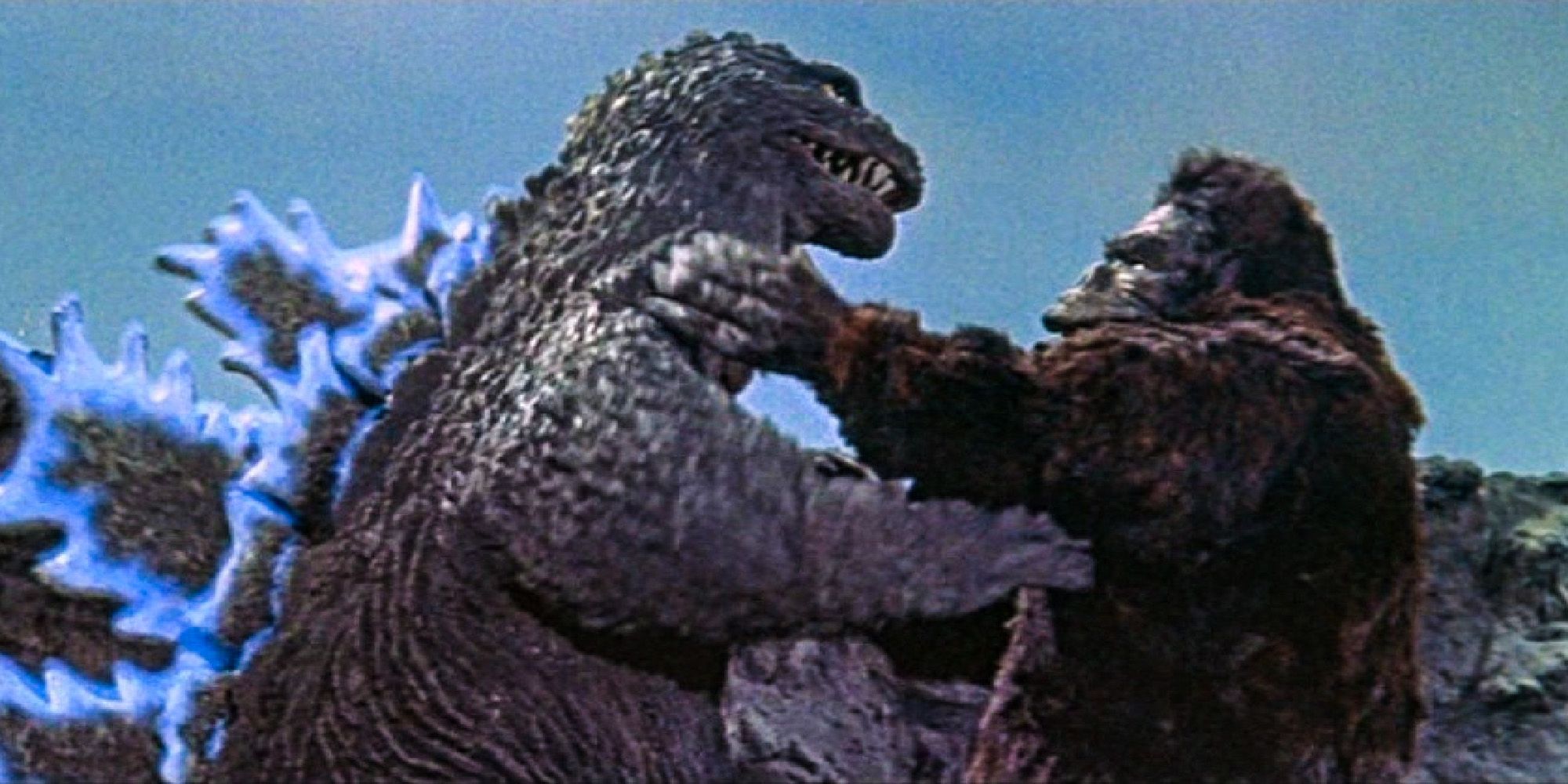
In a bid to boost ratings on the television programs Pacific Pharmaceuticals sponsors, company head Mr. Tako (Ichir? Arishima) sends a team to Faro Island to get King Kong. Meanwhile, Godzilla breaks out of an iceberg and, after a brief pitstop at an Arctic military base, makes his way to Japan.
The Japanese government forbids Mr. Tako from bringing King Kong to Japan, but the giant ape breaks free from the raft he is on and heads there anyways. Godzilla and Kong meet and Godzilla quickly makes it clear that Kong doesn?t stand a chance against him. Kong leaves the encounter, scratching his head and with singed fur. With the two monsters heading separately toward Tokyo, the government has a barrier of high tension wires erected around the city. The wires manage to stop Godzilla from entering Toyko, but Kong breaks through, taking strength from the electricity in the process.
Kong becomes infatuated with Fumiko Sakurai (Mie Hama) and carries her up to the top of the Diet Building. He is then put to sleep using berries from Faro Island and Fumiko is rescued. With Kong sedated in Tokyo, the decision is made to airlift him to Godzilla at Mount Fuji with the hope that the two monsters will kill each other. King Kong is dropped onto Mount Fuji near Godzilla and a viscious battle ensues. Just when it looks like Kong has lost, he is struck by lightening, giving him new strength. The two monsters battle their way through Atami, tearing apart Atami Castle, and then fall off a cliff into the sea. Kong resurfaces, swimming away from Japan in the direction of Faro Island, while Godzilla remains beneath the waves.
Like Mothra before it, King Kong vs. Godzilla is a light-hearted and even funny film, further cementing this new trend in Japanese giant monster cinema. Both the human characters and the monsters have their comedic moments, with Godzilla clapping his hands excitedly and Kong blinking wildly in surprise the first time he sees Godzilla unleash its atomic breath.
Still, King Kong vs Godzilla doesn?t abandon commentary for laughs. The primary target of the commentary this time is Japan?s television industry, which was taking off as Japan grew economically. At the time King Kong vs. Godzilla was made, television ratings wars were leading to ridiculous publicity stunts, something which is satirized by Mr. Tako trying to bring King Kong to Japan to boost ratings for the television shows Pacific Pharmeceuticals sponsors.
When Godzilla breaks out of the iceberg and heads to Japan, Mr. Tako becomes very envious of all the media coverage Godzilla is getting. To him, Godzilla is stealing the publicity he wants for his own company and sponsored TV programs. Later, when the government tells Mr. Tako he is not allowed to bring King Kong into Japan, he practically passes out.

Even after King Kong escapes and makes his way to Japan, Mr. Tako still remains focused on the attention the monster is generating. He completely ignores the destruction and death Kong is causing. When Godzilla and King Kong have their first encounter, Mr. Tako is shown rooting for Kong to beat Godzilla solely because King Kong is his monster.
Though the primary target of King Kong vs. Godzilla?s commentary is the televison industry, the film still has political overtones, albeit much more indirect ones than Mothra or Godzilla. King Kong is America?s most famous giant monster, and Godzilla is Japan?s. The United States and Japan had been bitter enemies less than 20 years prior to the production of this film. Also, in 1960, the Security Treaty between the United States and Japan was revised, something which was contentious in Japan at the time.
One last thing to note is that this is the first Godzilla movie in colour, and Godzilla?s atomic breath is shown to be blue. The blue breath is a nod to his nuclear origin, as Cherenkov radiation glows blue. This is stated in the film and is one of the few nuclear references in the movie.
King Kong vs. Godzilla was released theatrically in Japan on August 11, 1962. The film was a huge success there, with 12.55 million tickets sold, the most of any Godzilla movie to date. It remains the 13th most attended theatrical film in Japanese history.
The film was dubbed and heavily edited for its North American release. New scenes of American actors were shot and spliced into the film, though these generally consist of people talking into the camera and explaining what?s going on. These scenes bring the action to a hault, turning what was a genuinely funny and engaging satire into a bit of a chore to sit through. The North American distribution rights have been with Universal since 1963.
The heavily altered American edit of?King Kong vs. Godzilla?was the only version distributed in North America until 2019, when The Criterion Collection was able to secure the Japanese cut of the film for their?Godzilla: The Showa-Era Films, 1954-1975?Blu-ray set.??The American edit of?King Kong vs. Godzilla?is currently available on Blu-ray from Universal Studios Home Entertainment.??Both the American version and the Japanese version are available from The Criterion Collection as part of their?Godzilla: The Showa-Era Films, 1954-1975?Blu-ray set featuring the first 15 Godzilla movies.




